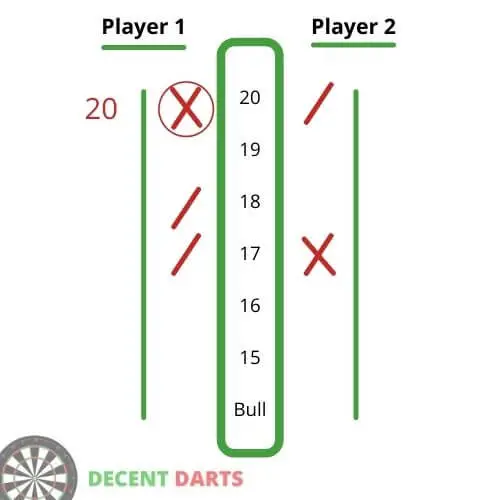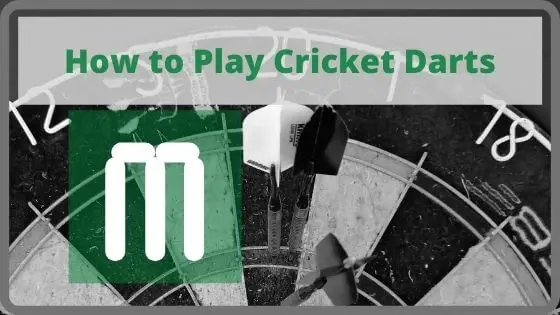While there are a lot of darts games, many of which we cover on this site, there are 2 – 3 in particular that are incredibly popular. Cricket darts is one of those games.
If you play the traditional game of darts like 501, then you’ll know the X01 dart games are the default. This is after all the game that professional players play, but cricket darts has grown in popularity over the years and is arguably the most popular darts game in the US, Canada, and Asia.
In this article, I’ll go over how to play cricket darts and give tips, tricks, and variations to either pick it up as a fun casual game or for more competitive players…
Number of Players
2 players or 4 players split into 2 teams
When you’re ready to play a round of cricket darts with more than 2 players, you will need to be split up into two teams. There is no set rule for team sizes. Average games are played with 2, 3 or 4 people, however, since there is no set rule on the number of players, people can still enjoy the game with larger teams.
Cricket Darts Objective
The objective of cricket darts is to be the first player/team to close all your numbers and have the highest score at the end of the round.
Cricket Darts Rules and Scoring
To play cricket darts, you will need to start out by getting the scoreboard prepared. Split the scoreboard into three columns. The two outer columns will be to keep track of Team A and Team B’s scores. The middle column will be a list of the numbers 15 through 20, and then the word Bullseye at the very bottom.
You can either use a regular marker board to set up your scoreboard like below, or you can use a specific cricket scoreboard like the Viper Dry Erase Scoreboard.

Each round will consist of players taking turns with 3 darts at a time. Each team’s initiative is to hit every number between 15 and 20 as well as the bullseye before the end of the game. If a player hits a number below 15, then it will be ignored.
The numbers in play are 15, 16, 17, 18, 19, 20, and the Bullseye.
You need to hit the number 3 times in order to close it, however, cricket darts still follows the usual scoring rules in darts. This means if you hit a single 20, you’ll mark it from your side with a “/”, if you hit another single 20, you’ll add another dash like this “X”. Once you hit single 20 for the third time, you’ll close out the number like this “⭙”.
The doubles and trebles are both in play so if you hit a treble 20 with your first dart, you will immediately close out the number and can start to score on it. Players can score on numbers that they’ve closed but that the opponents are yet to close. If both players have closed the 20, no one can score on it anymore.
All numbers must be closed out to win the game.
If one team closes out a number before the other team, they can start collecting points every time they hit that number until the game is finished. When both teams close out, the team with the most points wins.
How To Play Cricket Darts Game
- Split all the players into two separate teams, and decide which player from each team will play first.
- These two players will each throw a dart at the board and whoever scores closest to the bullseye will get to play first.
- Every player will be allowed to throw 3 darts per turn. Teams with more than one player will alternate which player throws each turn.
- Players will aim to close each number by scoring 3 points in it. Players have the option to close numbers in any order or a sequence. This should be discussed before the game starts.
- When players throw the darts and hit a ring, it will count for a certain amount of points (singles, doubles, and triples) and we recommend recording the points with different symbols so it’s easier to keep track. An easy way is using a dash / for singles, X for two hits, and ⭙ for three hits.
- If your team closes out a number before the other team, you can continue to score on that number. The number you score on is the number of points you will receive.
- Once both teams have closed all of the numbers and bullseye, you can calculate the final points to see who won the game.
Cricket Darts Example Game
Understanding how the game of cricket darts works is a lot easier when you have an example game to look at. Let’s take a closer look at how you can play cricket darts.
- The first player steps up to the dartboard. They throw their three darts, and score a triple 19, double 20, and double 14. The 14 is not on their agenda, so that doesn’t count for anything. The triple 19 will open up the 19 and they will need one more to open the 20. (Open means they can still score until both the other team closes that number out)
- The second player throws their three darts. They land a triple 19, a double 19, and a triple 18. This means they close out 19 and neither team can score on it, they won’t get any points for the double 19. They have also opened up the 18.
- Player 1 throws again and hits a triple 17, a single 17, and a single 20. They have opened up the 17, so they will receive 17 points for the single. They have also opened the 20 since they landed double the first time. This now puts the score up to 17-0.
- Player 2 throws and lands a single 18, a single 20, and a double twenty. They receive 18 points because they opened up 18 and they close out the twenty so neither player can score from it. Now the score is 18-17.
The game will continue to go in this fashion until all the numbers and bullseye have been closed out. For the more visual learners, check out this video below show an example game of how to play cricket darts:
Cricket Darts Tips & Strategies
Cricket is an individual game and it allows players to utilize their own strengths and weaknesses. Due to the simplicity of the game, there are very few strategies that can give you an edge other than your own ability.
Something you should focus on first then is playing to your own strengths. If you prefer throwing at the 19s, don’t try to throw for the 20 first time as you could miss your throw and give your opponent the opportunity to close this number out quickly and start to get on the scoreboard.
Another thing to keep in mind is to not just focus on scoring. If both players keep scoring on separate open numbers, no player will ever win the game. The objective is to close all numbers, your score is an additional bonus.
Therefore, aim to get in the lead of your opponent with a higher score and then aggressively try to close every number that they throw for. This won’t give them the time to score points if you keep closing the number while they are throwing for it.
Cricket Darts Variations
While cricket darts is a hugely popular game, it can get boring if it’s one of the only games you know how to play. It’s therefore good to have a few variations on the traditional game to mix things up and keep the game’s fun.
Pointless Cricket
Pointless cricket follows the standard rules of cricket but you do not keep score. This makes for an easier and less competitive game as it simply becomes a race. The player who can close all numbers first wins.
All-Numbers Cricket
All-numbers cricket follows the exact same rules as standard cricket with the variation being that all numbers now count towards your score. This is a game that will take significantly longer to complete so is best used for small teams or just 2 players.
A good strategy here is to go for multiple segments at once. What I mean by this is that if you try to close out the 16 and miss, you’ll still start to close out the numbers on either side which are 7 and 8. If however you stick with 20 and miss, the numbers on either side are 5 and 1 which will give you a much lower score.
This is irrelevant though if you are a good player and rarely miss.
Cut Throat Darts
Cut throat darts is a game ideally suited for 3 or more players. It follows the standard rules of cricket darts with one specific difference, the points you score are added to your opponents score rather than your own.
The aim of cut throat darts is therefore to finish the game with the least amount of points. This means an incredibly aggressive playing approach needs to be taken as you look to score highly with every single throw. Two players can even team up to eliminate a player.
Tactic Darts
Tactic darts is the UK version of cricket darts and uses the same standard rules with one difference, doubles and trebles become an additional requirement. Therefore, you can close out the 20 with 3 darts but you will also need to close out the double 20 and the treble 20 with an additional 3 darts each to fully close the number.
Scram Darts
I’ve got a full guide on scram darts if you want to check this variation out in more detail but the basic rules are that scram darts is played over two rounds. The regular numbers used in cricket (15 – bullseye) are in use but the difference is one player is a blocker and one is a score.
In round one, players take turns to throw 3 darts each, the “blocker” will try to close out all numbers as quickly as possible. The “scorer”, will try to score as many points as possible each throw on numbers that are not yet closed but the blocker.
Once all numbers are closed, the scorer’s total score is marked and players swap sides. This means the blocker now becomes the scorer. Repeat the game above until all numbers are closed. The player who scored the most points as the scorer is the winner.
Summary
Cricket darts is one of the most popular dart games around. It’s not only a great game for beginners but it’s also competitive, demonstrated by the number of leagues and competitions that you can play in just for this game alone.
^^ This is ideal for the players that don’t like 501 darts but still want to play competitive darts.
If you ever did get bored with cricket darts, the number of variations listed above means that there’s always an option to play it in some form depending on your preferences.

